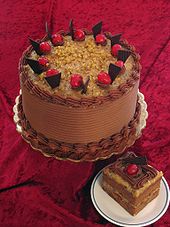Varieties
Cakes are broadly divided into several categories, based primarily on ingredients and cooking techniques. Yeast cakes are the oldest and are very similar to yeast breads. Such cakes are often very traditional in form, and include such pastries as babka and stollen. Cheesecakes, despite their name, aren't really cakes at all. Cheesecakes are in fact custard pies, with a filling made mostly of some form of cheese (often cream cheese, mascarpone, ricotta or the like), and have very little flour added, although a flour-based or graham cracker crust may be used. Cheesecakes are also very old, with evidence of honey-sweetened cakes dating back to ancient Greece. Sponge cakes are thought to be the first of the non-yeast-based cakes and rely primarily on trapped air in a protein matrix (generally of beaten eggs) to provide leavening, sometimes with a bit of baking powder or other chemical leaven added as insurance. Such cakes include the Italian/Jewish pan di Spagna and the French Genoise. Highly decorated sponge cakes with lavish toppings are sometimes called gateau; the French word for cake. A large cake garnished with strawberries Butter cakes, including the pound cake and devil's food cake, rely on the combination of butter, eggs, and sometimes baking powder or bicarbonate of soda to provide both lift and a moist texture. Beyond these classifications, cakes can be classified based on their appropriate accompaniment (such as coffee cake) and contents (e.g. fruitcake or flourless chocolate cake). Some varieties of cake are widely available in the form of cake mixes, wherein some of the ingredients (usually flour, sugar, flavoring, baking powder, and sometimes some form of fat) are premixed, and the cook needs add only a few extra ingredients, usually eggs, water, and someti

es vegetable oil or butter. While the diversity of represented styles is limited, cake mixes do provide an easy and readily available homemade option for cooks who are not accomplished bakers.Cheesecake is a dessert consisting of a topping made of soft, fresh cheese (not always cream cheese), usually on a crust or base made from hard biscuits (such as a graham cracker crust), pastry or sponge cake.[1] It may be baked or unbaked. Cheesecake is usually sweetened with sugar and may be flavored or topped with fruit, nuts, fruit sauce and/or chocolate. Various flavours of cheesecake exist, such as lemon, strawberry or toffee.Sponge cake is a cake based on flour (usually wheat flour), sugar, and eggs, sometimes leavened with baking powder which has a firm, yet well aerated structure, similar to a sea sponge. A sponge cake may be produced by either the batter method, or the foam method. Typically the batter method in the U.S. is known as a butter or pound cake while in the U.K. it is known as Madeira cake or Victoria sponge cake. Using the foam method a cake may simply be known as a sponge cake or in the U.K. occasionally whisked sponge, these forms of cake are common in Europe especially in French patisserie. The sponge cake is thought to be one of the first of the non-yeasted cakes, and the earliest recorded sponge cake recipe in English is attested to the 1615 book of English poet and author Gervase Markham entitled; The English Huswife, Containing the Inward and Outward Virtues Which Ought to Be in a Complete Woman.[1] Though it does not appear in Hannah Glasse's The Art of Cookery in the late 18th century, it is found in Lydia Maria Child's The American Frugal Housewife,[2] indicating that sponge cakes had been established at Grenada in the Caribbean, by the early 19th century.